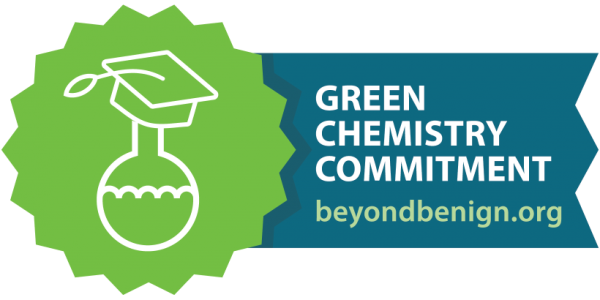Green Chemistry

Pioneering Colorado's Green Chemistry
It only takes a few minutes for a visitor to recognize how passionate chemistry instructors Niki Juhl and Tisha Mendiola Jessop are about making sure "putting people back into science" is something their students—and their colleagues—are always aware of. Whether this involves considering the impact of chemical processes on human health and well-being, understanding how green chemistry within lab courses reduces negative impact on the environment, finding ways to increase equity and diversity in STEM disciplines, or emphasizing the importance of learning to communicate scientific insights along with learning the concepts themselves, the two women are blazing new paths in chemistry education. Their students love it.
Mendiola Jessop and Juhl lobbied successfully for UCCS to sign a commitment contract with national green-chemistry organization Beyond Benign, making UCCS the first (and to date, the only) institution in the state of Colorado pledging to incorporate green chemistry in all its first-year labs, whether for their own majors or those in adjacent fields like health sciences, engineering, or science education. The commitment will eventually lead to incorporating green chemistry throughout lab coursework. Since UCCS trains many of our local K-12 science educators, this means classrooms throughout the region are gaining a deep appreciation of the human impact of chemistry.
Signing a commitment was just the first step. While Beyond Benign provides teaching materials for K-12 classrooms and upper-division college elective courses, Juhl and Mendiola Jessop noted that none existed for intro college courses—the places where learning to ask questions about the human impact of chemistry would transform how students think about chemical problems everywhere, in labs or everyday life. They also realized that the cost of many of the teaching materials was financially unfeasible for most school districts and college students. To remedy these issues, the two spent years developing original teaching materials designed to support a broad range of learning styles, and are currently pursuing a Creative Commons license for those materials so they can be used and adapted by teachers everywhere at no cost. Each lesson incorporates a written discussion of relevant green chemistry principles.
Another aspect of their ongoing efforts to ensure that UCCS chemistry is accessible and inclusive is the coordination of a "chemistry closet" to provide lab coats and other costly materials for any student who needs them. They eventually hope to add STEM-related professionalization gear to Clyde’s Closet or a similar campus-wide source.
Their human-centered work has garnered the two national attention, from invitations to present at conferences to requests that they give training workshops. Nonetheless, their faces light up most powerfully when discussing their UCCS classrooms and how they get students to rethink chemical processes in terms of their everyday experiences. "We want to find ways to be sure the people are always there" in any research project, notes Juhl, detailing how students learn quickly that any research question is worth asking, because “we all care for people, and chemistry impacts those people.” Mendiola Jessop gives examples: "We use in-class activities to increase student understanding of equity and diversity. Maybe we're discussing diabetes. So we do a whole lesson on carbohydrates--but then we ask students about social determinants of health conditions. Who gets diabetes? Why? Who has access only to fast carbs?" Both instructors are adamant that the best chemistry incorporates insights from many other fields, whether STEM, social science, or humanistic fields.
The instructors also note that today's students live in a world that "asks them to be active"—they recognize that students are most engaged when they understand why the lessons matter in real life. Says Mendiola Jessop, “They want their learning to make a difference.” Students in their courses choose research projects that allow them to work toward solutions to problems they have encountered in their daily lives—and practice communicating those solutions successfully to a broad audience through in-class training in creating infographics, newsletters, presentations, and other media.
"Our students learn the same content as any chem student," says Juhl. "They're just learning it through the lens of green chemistry that is safer for people and for the planet." Mendiola Jessop agrees. "Green chemistry is human chemistry."